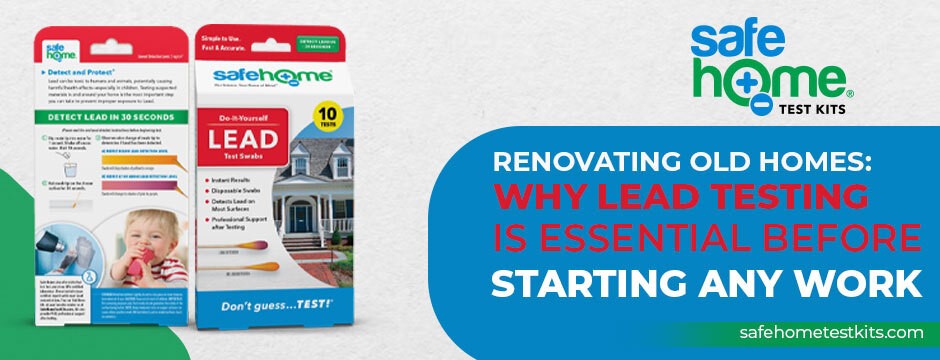Renovating Old Homes: Why Lead Testing is Essential Before Starting Any Work

Renovating old homes is a labor of love, preserving history and reviving architectural gems. However, beneath the charming exteriors and vintage charm, there may be hidden risks that could jeopardize the health of occupants and workers. Lead-based paint, commonly used before 1978, poses a significant threat during renovations. This comprehensive guide will delve into the importance of lead testing before embarking on any renovation project in older homes. Let’s uncover why lead testing is crucial to ensure old houses’ safety, compliance, and restoration.
Understanding Lead Hazards in Old Homes
Lead-based paint, once popular for its durability and vibrant colors, is now recognized as a significant health hazard, especially in homes built before 1978. The paint used in these homes contains lead, a toxic metal that can lead to severe health issues upon exposure. The most vulnerable groups are children and pregnant women, as lead exposure can lead to developmental delays, learning disabilities, and behavioral problems. Even low levels of lead exposure can be harmful. Disturbing lead-based paint during renovation can release lead dust and chips into the air, further increasing the risk of exposure.
Legal Requirements and Regulations
In response to the health risks associated with lead-based paint, the Environmental Protection Agency (EPA) introduced the Renovation, Repair, and Painting (RRP) rule. This rule mandates that contractors and renovators working on homes built before 1978 must be trained and certified to handle lead-based paint safely. Moreover, homeowners must receive information about lead hazards before signing a renovation contract. Lead disclosure requirements are also crucial when selling or renting older homes, informing potential occupants about possible lead risks.
According to the EPA, homes built before 1940 are more likely to contain lead-based paint, with a staggering 87% probability. Homes built between 1940 and 1959 have a 69% probability, emphasizing the prevalence of lead-based paint in older homes.
The Renovation Process and Lead Exposure
The process of renovating old homes, while exciting, can inadvertently release lead hazards into the environment. Sanding, scraping, and demolishing surfaces coated with lead-based paint can create lead dust and chips, endangering workers and inhabitants. These hazardous particles can settle on floors, furniture, and other surfaces, posing a risk of ingestion or inhalation. Understanding the renovation process’s potential to disturb lead-based paint emphasizes the importance of lead testing before any work begins.
Before starting any renovation work, seal off the work area with plastic sheeting and secure openings to prevent lead dust from spreading to other parts of the home.
Benefits of Lead Testing Before Renovation
Before beginning a renovation project, conducting lead testing is essential. It allows for the early detection of lead hazards, enabling you to implement appropriate safety measures. Testing provides accurate information about the presence and concentration of lead on various surfaces. With this knowledge, homeowners and contractors can make informed decisions about how to proceed with the renovation and integrate lead abatement strategies if necessary. Ultimately, lead testing saves time money, and most importantly, protects the health of everyone involved.

Lead Testing Methods and Professionals
Several lead testing methods are available to assess the presence of lead-based paint. Paint chip analysis involves collecting samples and sending them to a laboratory. XRF (X-ray fluorescence) devices use radiation to detect lead in paint layers. Dust wipes can determine the presence of lead dust on surfaces. Hiring certified lead inspectors or risk assessors ensures accurate results and professional guidance for a safe renovation process.
According to the CDC, more than half a million children in the United States have blood lead levels high enough to cause developmental and behavioral problems.
Incorporating Lead Abatement Strategies
If lead hazards are detected through testing, incorporating lead abatement strategies becomes imperative. Encapsulation involves covering lead-based paint with a special coating to prevent its deterioration. Enclosure creates a barrier between occupants and the lead-based paint, effectively isolating it. In cases of severe lead contamination, removal may be necessary. Experienced professionals play a pivotal role in implementing these strategies safely and effectively, maintaining the balance between historical preservation and health concerns.
DIY Renovators and Safety Precautions
For homeowners undertaking DIY renovations in older homes, safety precautions are paramount. Wearing appropriate protective gear, including masks and gloves, can minimize exposure to lead dust and particles. Creating containment areas with plastic sheeting prevents the spread of dust to other parts of the home. Proper cleanup and disposal of lead dust and debris further mitigate risks.
Consider using a HEPA (High-Efficiency Particulate Air) vacuum cleaner designed for lead dust cleanup to ensure thorough cleaning after renovations.
Laboratory Certified Testing for LEAD
Safeguarding your home from lead contamination is now easier with Safe Home’s DIY Lead Test Swabs. These convenient swabs offer a swift and simple method to identify lead presence on various surfaces in and around your living space. With instant results, you’ll swiftly gain crucial insights, enabling well-informed decisions and timely corrective actions if lead is detected. The pressing issue of lead poisoning affects countless individuals who encounter everyday items tainted by this hazardous metal. This concern is especially critical for vulnerable groups like children, seniors, and pets. Alarming statistics from the CDC reveal that over 10 million U.S. households with children face exposure to elevated lead levels. By utilizing Safe Home® Lead Test Swabs, you proactively ensure your family’s safety, taking the essential initial stride toward cultivating a healthier living environment for your cherished ones.

Conclusion
Renovating old homes offers a unique opportunity to breathe new life into historic properties. However, the potential hazards of lead-based paint cannot be ignored. Lead testing is fundamental before beginning renovation work in older homes. It safeguards the health of occupants and workers, ensures compliance with regulations, and contributes to the responsible restoration of historical treasures. By prioritizing lead testing, you can confidently embark on your renovation journey, transforming old homes into safe, beautiful spaces that stand the test of time.


